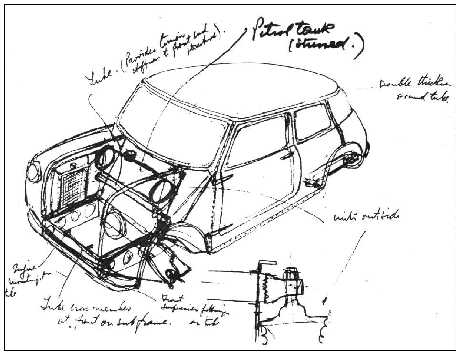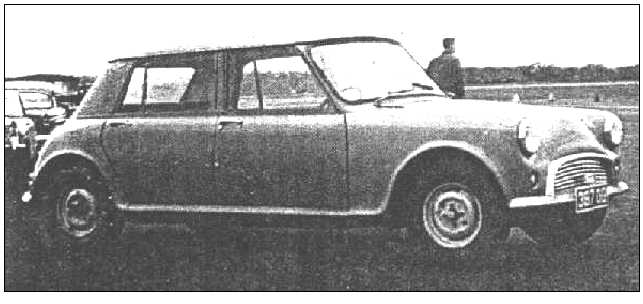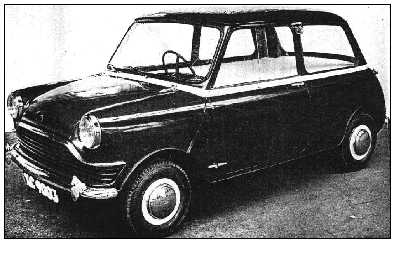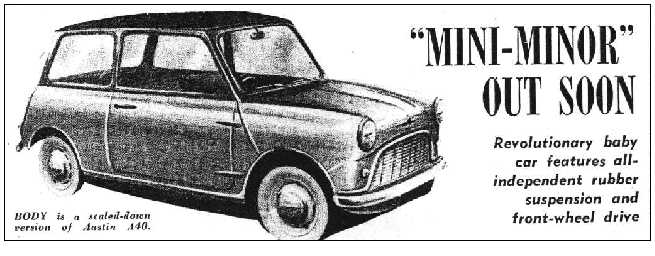|
From The Production Line
With Nairn Hindhaugh
Nairn worked for BMC in the days when the mini was being built and more than likely saw most of our minis come off the production line.
Who would think a tiny little box on even more tiny wheels would win the hearts and minds of over 5 million motorists, would put a new word in the language and be put forward as a contender for the Car of the Century? It is one of the all-time classic designs, a lot of fun when it came out, still with us in the 1990s, as much fun now as it was then.
As it's nearly 40 years since this incredibly influential little car started to grace the world's roads, perhaps it may help to set the scene.
In 1952, the large British competitors, the Austin Motor Company and the Nuffield Organisation merged to form the British Motor Corporation (BMC). Nuffield was the group which consisted of Morris, MG, Wolseley and Riley, and it was felt that if Britain was to make a go of it in the post war car markets, then a large corporation could do it. The eventual boss of BMC was Leonard Lord, who came up through the Austin ranks, although he had started out with Morris before the war. One of the most brilliant designers in the new company was Alec Issigonis, who had already made a name for himself with the incredibly successful Morris Minor, announced in 1948.

Issigonis had been experimenting with the idea of a transverse engine and power train as far back as the early 1950s. He certainly wasn't the first; the Germans had tried it in the 1930s with DKW and NSU, and there had also been some large capacity motor bikes using this method as well. However, none had been very successful, and no-one had put it into large-scale production.

His experimental vehicles were all very unorthodox at the time, and one of the first looked similar to the Austin 1800 which finally emerged in 1964. Apart from trying out the concept of transverse engines, he also dabbled with fluid suspensions. One of his goals was to have as much usable interior space within the shortest possible overall length, and if you look at all his creations, like the Mini, 1100 and 1800, they all achieved this by having a wheel at each corner.

In 1956, the Suez crisis had erupted, and fuel became scarce in England to the point where it was being rationed. The British car market became almost overwhelmed with 'bubble' cars, such as Isetta, Heinkel, and Messerschmitt - all coming in from Europe. Lord insisted on driving these invaders back into the sea, and Issigonis' new small car seemed the ideal way to do it. There is the legendary tale of Lord being taken for a spin round the block in a prototype Mini in July 1958, and never being one to mince words told Issigonis to "Put the bloody thing into production as soon as possible".
It must be remembered, however, that BMC at the time, was one of the most conservative car-making companies on earth. Not for them were there any rear-engined creations, such as VW or Renault, or anything like the complexities of France's Citroen.
The sort of cars in BMC's stable were really a lot of old worthy family saloons, such as the Morris Oxford and Austin Cambridge, although there was a sporting heritage in MG and Riley. That something as revolutionary as the Mini being given the green light says a lot for their management team.
So, what stage would the car be right now, forty years ago? Because of the differences in the construction of the Mini and more conventional cars such as the Morris Minor and Austin A35, new assembly lines at both Longbridge (the Austin works) and Cowley (Nuffield's plant) would have been set up, and all the prototype testing would still be in full swing.
Two cars emerged from Longbridge by April 4th, and ten from Cowley by May 9th. Disguised versions sporting Austin A35 vertical grilles were seen running around, although you'd wonder at why they would go to this trouble when it came from the same company.
.

The British summer of 1959 was to be unusually dry, and this was going to have some effect, as they didn't find out about water leaks until the car was well and truly in production.....
By now, some of the motor magazines and newspapers had a whiff that there was to be a revolutionary small car coming from BMC, but were not sure how radical it really was.
The more 'respectable' magazines, like Motor and Autocar refrained from using any scoop shots, but some others ran spy drawings, particularly the French. The public release day was slated torward the end of August.
By then, Britain, and indeed the rest of the world, would see this funny little box on wheels which won so many people over, but who would have thought it would be in production for over forty years?
|